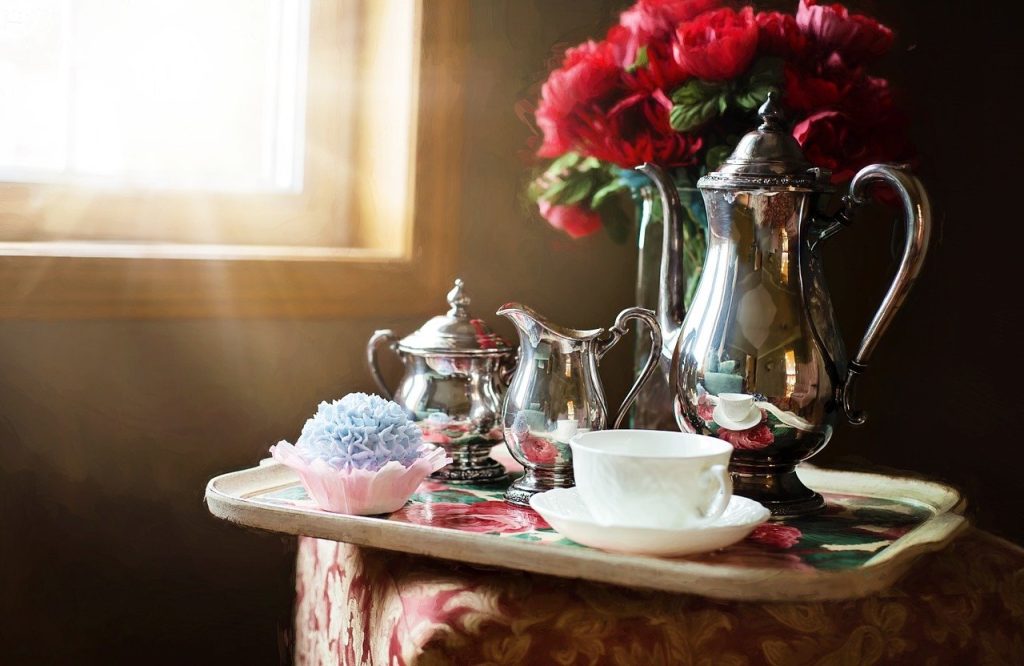Vinegar is an all-purpose cleaner for your home. It’s great for cleaning countertops, the floor, fabrics, and even utensils like kettles and pots.
If you have a teapot, vinegar is one of the easiest and safest products to use for removing rust, mineral deposits (scale), and stains.
How To Deep Clean A Teapot With Vinegar?

You don’t need to use vinegar every time you clean your teapot. A quick rinse with hot water after each use is enough to clean the teapot.
For clay teapots, you don’t even need to clean it (assuming you don’t add any milk or sugar to the teapot). Letting the tea flavours absorb in the teapot over time produces better tasting tea.
For stainless steel and glass teapots, you can rinse or wash with regular dish soap and a soft cloth or sponge.
Save the vinegar for the occasional deep clean or when you notice a buildup of rust, stains, or scale in the teapot.
Here’s how to deep clean your teapot with vinegar. Regular white vinegar works fine.
- Boil water in a kettle. Don’t boil water in the teapot. A teapot is meant for steeping tea and shouldn’t be used on the stove.
- Mix the hot water and vinegar in a 50:50 ratio. Add the mixture to the teapot and close the lid.
- Let the teapot sit for an hour or two, or overnight if you want an extra-deep clean.
- Pour out the vinegar solution then rinse the teapot with warm water.
- Wipe the inside with a sponge to remove any remaining stains or deposits. Rinse again with warm water and leave the teapot upside down to dry.
Clean the teapot with vinegar about once a month to keep stains, tea residue, and scale from building up.
This keeps your tea tasting good and prevents other bad stuff like mould from growing inside the teapot.
It’s also a good idea to clean a new teapot with vinegar. It removes any dirt, oils and residues left over from the manufacturing process.
Does Vinegar Remove Rust From A Stainless Steel Teapot?
In addition to tea stains and scale, vinegar can also remove rust from the inside of a stainless steel teapot.
Vinegar, which is an acid, dissolves the rust in the metal.
Follow the same process as above. If the rusting is severe, add a tablespoon of salt to the vinegar solution. This will increase the acidity of the vinegar and make it more effective at dissolving rust.
Once the vinegar solution has soaked into the teapot for an hour or more, the rust should come off when you pour out the mixture.
Wipe the inside of the teapot with a sponge to remove any remaining rust.
Rinse the teapot at least twice with warm water to clean it fully and remove the taste of vinegar. Leave it upside down to dry.
Is Vinegar Safe for Glass Teapots?
One of the best things about cleaning with vinegar is that it’s safe for most types of surfaces and materials.
It’s safe to clean stainless steel as well as a glass teapot with vinegar. And it doesn’t even have to be diluted.
Undiluted vinegar is still safe for both stainless steel and glass, and can be more effective at removing stains and deposits.
You just need to be extra thorough when rinsing to make sure you get rid of all the vinegar taste.
Can I Use Vinegar To Clean A Clay Teapot?
Clay teapots like Yixing require the most delicate care when it comes to cleaning.
The golden rule is that you should never use soap to clean a clay teapot. The porous material will absorb soap and your tea will taste off.
What about vinegar? Won’t it also make your tea taste unusual?
Diluted vinegar is generally okay to use for cleaning the inside of a clay teapot. Use a 2:1 or 1:1 water and vinegar ratio depending on how dirty the teapot is.
Mix the vinegar with hot water then add it to the teapot. It’ll remove scale deposits, stains, as well as any mould that has formed on the porous surface.
After about an hour, pour out the vinegar solution and rinse the teapot 2-3 times with hot water to completely get rid of the vinegar taste.
If you are afraid of using vinegar, you can use just hot water. Leave it to soak in the teapot for an hour then rinse.
How to Clean A Teapot Without Vinegar
If you don’t have vinegar in your kitchen don’t worry, there are several other products that work just as well.
Here are some alternatives.
- For everyday cleaning, just use warm water to rinse the teapot. It’s good enough for stainless steel, glass or clay teapots. You can also use a sponge soaked in soapy water (use regular dish soap) to wash the inside and outside of a stainless steel or glass teapot.
- For stains, scale, and rust, baking soda works great for stainless steel and glass teapots. Add a couple of tablespoons to hot water in the teapot and let sit for an hour or several hours depending on how dirty the teapot is. Here’s a video explaining how to clean a stainless steel coffee pot (also works on teapots) with baking soda.
- If you don’t have baking soda, denture tablets are effective descalers and rust removers. Add two tablets to hot water in the teapot and leave it to soak for sometime. Use denture tablets only for glass and stainless steel teapots.
- Lemon juice, because of its acidity, is also good for removing rust, stains and mineral deposits from a stainless steel or glass teapot. Mix a bit of it with hot water and leave the solution to soak in the teapot.




